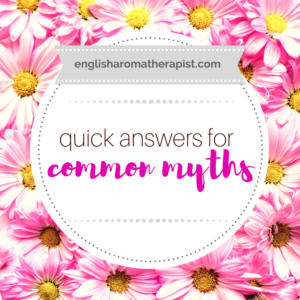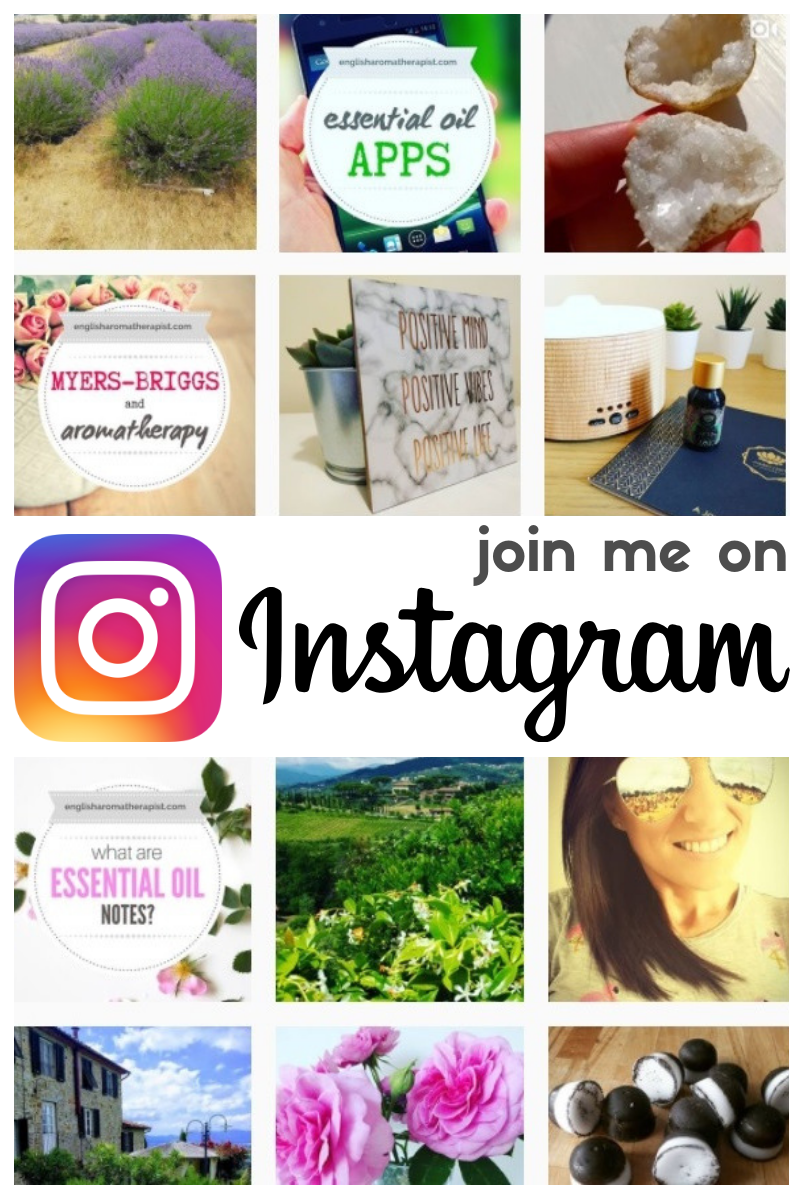Quick Answers to Common Myths

There are so many myths about essential oils and aromatherapy. Of course, some issues will always be a matter of opinion. Many things are not purely black and white. I am NOT here to say I know it all!
But there are some myths that keep circulating round. When we hear them, it’s not always easy to quickly find articles or links to back up our claims.
I thought it would be easy to gather a collection of links in one place, for quick answers to those common myths we hear every day.

“It’s healthy to drink essential oils in water every day!”
The only people who think this is a good idea are essential oil sales reps who are trying to maximize their commission. You won’t find any professional qualified aromatherapists who think it’s a good idea to drink drops of essential oils on a regular basis.
There is no long-term safety record of casual essential oil ingestion, and the future consequences on our bodies are unknown. The potential risks include serious damage to your internal organs. It can take years for the cumulative effects to surface, at which point it can be devastatingly too late. It can be likened to playing Russian roulette with your health. An absence of immediate symptoms does NOT make it safe. Oh, and FYI: drops of essential oil are not “diluted” in water.
Further reading:
The truth about drinking essential oils in water
Friends don’t let friends drink essential oils
Why essential oils are not water flavoring agents
Robert Tisserand interviewed on ingestion, dilution and other safety issues
No more essential oils in your water!

“My oils are pure enough to use undiluted!”
It’s a common misconception that “therapeutic grade” oils are safe to use neat on the skin. I would urge anyone who believes this to read the latest Aromatherapy United Injury Report 2016 for a sobering insight into the potential consequences of undiluted topical use. Even 100% premium quality essential oils need to be diluted before being applied to the skin.
Further reading:
Why should we dilute essential oils?
Why is essential oil dilution important?
Guide to diluting essential oils
New survey reveals dangers of not diluting essential oils
“There is no such thing as a ‘safe’ brand of essential oils” (Tisserand)
Safety statement – Alliance of International Aromatherapists

“This is the French way to use essential oils – the British method is outdated”
This is a common response to anyone who dares to criticise casual ingestion. In fact, the concept of ‘French’ and ‘British’ schools of aromatherapy is utter nonsense, and actually invented by an MLM company to justify internal use. Their reps are told that the so-called ‘British’ method is conservative and outdated. They like to promote the idea that essential oils are commonly ingested in France – in fact, essential oils are only occasionally prescribed for internal use, in carefully controlled circumstances.
Further reading:
The “British” school of aromatherapy?
The truth behind aromatherapy schools of thought
British vs. French Aromatherapy’ – a myth… or a smokescreen?
.

“Essential oils are natural and much safer than toxic chemicals!”
This is a flawed argument (known as an Appeal to Nature), commonly followed by claims such as “if it’s natural, it must be safe!” and “I’d rather trust what God has given us than toxic chemicals!”. But if essential oils are so powerful, why would they not also have the power to cause negative effects, as well as positive ones? People like to promote essential oils as a cuddlier alternative to scary medications from the “Big Pharma”. It’s not surprising that the idea of self-medicating at home is more appealing than visiting the doctor. This doesn’t mean that essential oils can be used without due care. If used incorrectly, essential oils can cause serious skin irritation, sensitization and internal damage.
If you think essential oils can be used liberally without any adverse effects, take a look at the Aromatherapy United Injury Report 2016.
Further reading:
2016 Aromatherapy Injury Report
Essential oils and the detox theory

“It’s fine to ingest essential oils – they’re GRAS safe!”
Again, this is a highly flawed argument. Just because essential oils are used (in minuscule amounts) as flavourings in the food industry, this is NOT justification to casually ingest whole drops at home.
Further reading:
GRAS essential oils: Safe to ingest?
Essential oils and GRAS – What it really means
Can essential oils be ingested?
Is it Safe to Ingest Essential Oils? What the Sales Reps Aren’t Telling You!

“I’ve been doing it for ages, and I’m fine!”
So, you’ve been drinking essential oils for years and feel fabulous? You use them neat all the time, and have never experienced a bad reaction? You think Raindrop Therapy is the best thing ever invented? You’ve been doing it for ages, and you’re fine? Well, this is about as scientifically valid as saying “I’ve been driving without a seatbelt for years, and I’m still alive!” It’s a classic anecdotal fallacy. A smoker could argue “Well, I’ve smoked cigarettes for years, and I don’t have lung cancer!” – but it doesn’t take away from the fact that we know smoking does increase the risk of lung cancer.
Just because someone told you they always ingest essential oils/use them neat and they’re “fine” – this does not make it safe. It can take months, or years, for internal damage or sensitization to rear its ugly head. And if you’re wondering…why would they promote such advice if it’s “so dangerous”? Clue: $$$
Further reading:
Top 10 Truths About Essential Oils

“There’s only ONE brand that sells pure, therapeutic grade essential oils!”
This is probably the biggest myth out there, and one that is often misunderstood. Terms like “certified pure therapeutic grade” are nothing more than a self-awarded marketing term. There is no independent body that certifies whether essential oils are therapeutic grade or not. Any 100% pure essential oil is technically therapeutic grade. Obviously, some oils will be of a higher quality than others, and it’s important to choose a reputable supplier. But to suggest that all other essential oils are worthless is pure fiction.
Further reading:
Therapeutic grade essential oils – AromaWeb
The quality of essential oils – Jade Shutes
Essential Oil University – Therapeutic grade essential oils
15 things you should know about essential oils

“If the label says ‘Not for internal use’ it means it’s not 100% pure”
Again, this is a claim that’s often made by those who are trying to justify the prices of MLM essential oils. In reality, if the label says “not for internal use” this is mainly for legal liability reasons. It has nothing to do with the purity of the oil – even the highest quality essential oils should not be drank out of the bottle. Internal use is never a good idea, unless specifically prescribed by a clinical aromatherapist (no matter what any sales rep might tell you).
Further reading:
Essential Oil Myth #16 (Essential Oil University)

“The Tisserand safety approach is based on old science”
This is often quoted by MLM reps who have been led to believe that professional aromatherapy safety guidelines are outdated. Several times I’ve had reps tell me that my knowledge of aromatherapy is wrong. “Times have changed!” they say. “You need to open your mind!” another said. “I used to think you couldn’t ingest essential oils, but now I’ve seen the light!” Ironically, if anyone needs to be more open-minded it’s those people who believe all the marketing hype.
The current edition of Essential Oil Safety by Tisserand & Young was completely updated and rewritten in 2013. This is new information, not old science. Robert Tisserand is not someone to rest on his laurels, and pointed out that he spends at least a couple of hours each week studying new essential oil research.
Further reading:
Essential Oil Safety (2nd Edition)
Robert Tisserand interviewed on ingestion, dilution and other safety issues

“Aromatherapy doesn’t even work!”
Some people won’t take aromatherapy seriously because they believe it has no scientific basis. In reality, aromatherapy-related scientific research is being carried out all the time. The PubMed website is an online index of medical studies. Type “essential oil” into the search box and you’ll see over 7,000 results. These are real, scientific studies with quantifiable results. Check out this post for 100 examples of aromatherapy-related studies to start you off!
Further reading:
Where’s the scientific evidence?

“Any redness is just a sign of detoxing”
This is a common myth that’s perpetuated by MLM brands and their sales reps. If someone experiences redness, itching or skin irritation after using essential oils, they’ll often be told that it’s just a sign of detoxification. This is false and dangerous advice, which can have serious consequences. What’s particularly worrying is when we see this “advice” applied to babies and children (such as in this Raindrop Therapy for Babies video). If you experience any adverse reactions from using an essential oil – STOP using the oil!
Further reading:
Essential oils and the detox theory
Essential Oil University – Myth #6
Skin Irritation vs Sensitization – Your Skin is Not Detoxing
Are there any other common myths about essential oils that you keep hearing again and again? Let me know in the comments below!
What to Read Next: How to Spot a Logical Fallacy
Follow me on...
Share this on...
